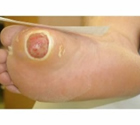Skin Care / Wound care
The skin is the largest organ of the body and undergoes significant changes during the ageing process. As the layers of the skin change, its normal function as a barrier to infection, protection, temperature and water regulation are affected, making the older adults more susceptible to damage from moisture, friction or trauma.
The incidence of skin tears, pressure injuries, chronic leg ulcers and diabetic foot ulcers increases with age and therefore this is a serious issue for older adults.
 |
 |
 |
 |
| Skin Tear | Pressure Injury | Chronic Leg Ulcer | Diabetic Foot Ulcer |
Once there is a breakdown of the skin, wound healing in the older person is slowed due to the reduced ability of the skin to regenerate and reduced immune system in this population. Due to the debilitating effects these conditions can have on the older person, prevention through maintaining good skin integrity is vital in the care of an older person.
Being able to recognise factors that can impact on the wound healing process is essential so that you can take steps to either remove the factors slowing down the wound healing process or, if possible, minimise their impact. Some factors, other than age, that may impact on the wound healing process include:
| Factor Explanation | |
|---|---|
| Health of the client | Illnesses such as renal failure, heart failure and diabetes increase a person's risk of suffering impaired wound healing because of the way these diseases affect all body systems. |
| Nutrition and hydration | Poor nutrition and hydration will slow down the wound healing process because the body will not have enough nutrients to promote wound healing. A wound increases the body's need for nutrients, protein and energy. |
| Medications | Some medications that make the blood less likely to clot (e.g. anticoagulants), cytotoxic medications or steroids (e.g. taken for conditions such as rheumatoid arthritis) make the skin thinner and more likely to tear. |
| Psychological state | There is a link between high levels of stress and impaired wound healing. |
| Decreased blood supply | Hardened, narrowed or blocked arteries reduce blood supply to the skin. This slows down wound healing because blood carries nutrients and oxygen. |
| Infection | The presence of a wound infection slows down healing. |
| Pressure, friction, shear | Dry skin is more likely to tear due to friction, shearing, moisture or pressure. |
| Temperature | Wounds need a stable temperature and enough warmth to promote a good blood supply to assist the healing process. |
| Loss of sensation | Decreased sensation, loss of consciousness, an injury to the central nervous system, a cerebrovascular accident, major surgery or spinal cord injury increase the risk of skin damage. This is because the client may not be aware that an injury to the skin has occurred. |
| Smoking | Cigarette smoking is a well-known risk factor for impaired wound healing because it leads to hardening of the arteries (atherosclerosis), peripheral arterial constriction and ischaemic heart disease. |
Tips for maintaining good skin integrity
Do
- Eat a nutritious diet
- Drink 6-8 glasses of fluid every day
- Wear loose cotton clothing
- Moisturise skin twice daily
- Pat skin dry. Do not rub
- Use absorbent, disposable incontinence products if needed
- Barrier creams and films can prevent damage to skin
- Change position frequently
Don't
- Do not use products that irritate the skin. Eg. Perfumed lotions
- Do not use soap. Try soap-free cleansers
- Do not wash excessively – water dries the skin
- Do not rub the skin over bony areas
- Do not use tapes or adhesives on the skin
Thinking challenge
Why is the skin so important for us?
Answer: The skin protects our body, controls our temperature, allows us to feel pain, helps us metabolise Vitamin D and produces sweat and oils. The skin has many functions and it is important to know how normal skin works so if a problem occurs you are able to take steps to minimise the impact of the problem. For example, older people may not be able to regulate their body temperature so will often feel cool even on warm days.
Which skin changes are typical of people as they age?
Answer: The skin becomes drier, thinner, more likely to become infected and bruises more easily.




